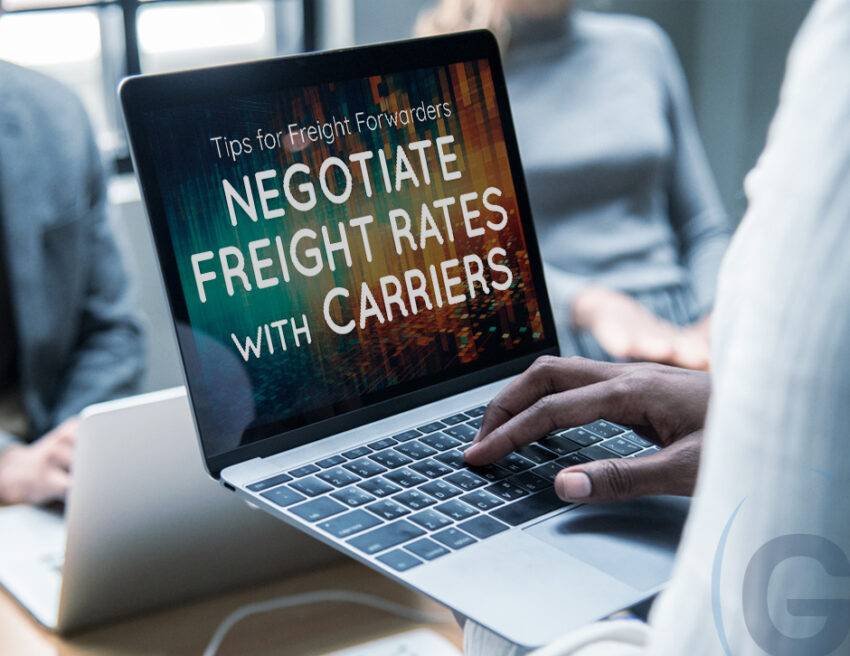Freight forwarding is a dynamic and complex industry, where one of the most critical tasks is negotiating freight rates with carriers. The ability to secure favorable rates not only impacts a freight forwarder’s profitability but also their service quality and competitiveness. In this guide, we’ll cover essential strategies to help independent freight forwarders improve their negotiation skills with carriers and achieve the best possible rates.
Understanding the Market: A Key to Better Negotiation for Independent Freight Forwarders

Market Research and Trends
Before initiating any negotiation, it’s crucial to have a thorough understanding of the current market landscape. Freight rates fluctuate due to various factors such as fuel prices, demand and supply imbalances, seasonal trends, and global economic conditions. Independent freight forwarders need to stay informed about these variables through in-depth market research.
Being aware of peak seasons, economic cycles, and shifts in demand will help you better anticipate changes in rates. This knowledge allows you to set realistic expectations and strengthen your bargaining position when negotiating with carriers.
Competitor Analysis
Knowing how your competitors are negotiating and the rates they offer can give you a competitive edge. Analyzing their strategies can reveal market trends and opportunities, while also helping you highlight the unique advantages your business provides. Use this insight to enhance your value proposition and bring something extra to the negotiation table.
Breaking Down Freight Rates
Components of Freight Rates
To negotiate effectively, it’s important to understand the various components of freight rates. These include the base freight rate, fuel surcharges, security fees, and other ancillary charges. By breaking down each element, you can identify areas where potential savings can be made or where unnecessary charges can be eliminated.
Rate Variability
Freight rates are influenced by several factors, including shipment volume, weight, dimensions, type of goods, and the shipping route. For instance, larger shipments may qualify for volume discounts, while specialized goods may incur additional fees for handling. Understanding these variables will allow you to assess the offered rates more accurately and find opportunities for negotiation.
Preparing for the Negotiation
Gathering Data
One of the most important steps in negotiation is preparation. Gather all relevant data, including historical shipment records, average volumes, and any specific shipping requirements (e.g., temperature control or expedited services). Being armed with precise details gives you a strong foundation to negotiate from and demonstrates your knowledge and preparedness to the carrier.
Setting Clear Objectives
Define your objectives before entering the negotiation. Do you want lower rates, more flexible terms, or additional services? Setting clear goals ensures that you remain focused and can effectively measure the success of the negotiation.
Developing a Strategy
Once you have your objectives and data in hand, develop a strategy to guide the negotiation. Prepare responses for different scenarios and anticipate the carrier’s counteroffers. Having a strategy will help you steer the conversation in your favor and react confidently to any proposals.
Effective Negotiation Strategies
Highlighting Your Value
One of the most effective strategies is to emphasize the value your business brings to the carrier. This could include consistent shipment volumes, timely payments, long-term partnerships, or the potential for future business. Showing the carrier how they benefit from your business increases your chances of securing better rates.
Bundling Services
Another way to gain leverage is to bundle services. For example, offering the carrier a combination of sea, air, and land transportation needs can lead to better rates overall. By consolidating your business with one carrier, you give them more value, which can incentivize them to offer competitive terms.
Exploring Multiple Carriers
Don’t limit yourself to one carrier. Explore options with multiple carriers to gather competitive quotes. Knowing you have alternatives puts you in a stronger position to negotiate better rates and terms.
Building Relationships with Carriers
Long-term Partnerships
Fostering long-term relationships with carriers can result in more favorable rates and service agreements. Carriers are more likely to offer better deals to clients they trust and have a proven track record with. Building mutual trust through clear communication and honoring commitments is key to forming strong, lasting partnerships.
Communication and Transparency
Transparent communication is essential for successful negotiations. Be clear about your needs and expectations and encourage the carrier to do the same. Open dialogue leads to mutually beneficial solutions and helps to build trust over time, which can improve your negotiation outcomes in the future.
Handling Counteroffers and Objections
Active Listening
When carriers present counteroffers or raise objections, actively listen to their concerns. This demonstrates respect and a willingness to collaborate, which can help you better address their needs and find solutions that work for both parties.
Firmness with Flexibility
While it’s important to remain firm on your core objectives, being flexible on less critical aspects can help you find common ground. If a carrier counters with a higher rate, consider negotiating other terms such as better payment conditions or additional services to offset the cost.
Finding Win-Win Solutions
Strive for win-win outcomes, where both you and the carrier benefit. By compromising on some points while securing key gains, you can build a positive relationship that will lead to smoother negotiations in the future.
Going Beyond Rates: Adding Value
Value-added Services
Instead of focusing solely on rates, consider negotiating for value-added services such as priority handling, faster transit times, or enhanced tracking features. Even if the rates remain slightly higher, these services can improve customer satisfaction and add value to your offerings.
Flexibility and Contingencies
In the fast-moving world of logistics, flexibility is essential. Negotiate for contingency plans that accommodate changes in delivery schedules or shipment rerouting without excessive penalties. Having flexibility in your agreements can save you money and reduce stress when unexpected situations arise.
Leveraging Technology in Negotiation
Freight Rate Management Tools
Technology can play a major role in improving your negotiation process. Tools like FreightViewer, an online freight rate management platform offered by Globalia Logistics Network, allow forwarders to compare rates, set profit margins, and send quotations quickly. Using such tools provides you with data-driven insights, helping you make more informed decisions.
Conclusion
Negotiating freight rates is a vital skill for independent freight forwarders. By understanding the market, preparing thoroughly, and adopting strategic negotiation tactics, you can secure better rates and terms, improving both profitability and service quality. Remember, successful negotiations are about more than just low rates—they’re about finding the best value for your business.


